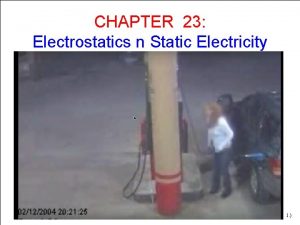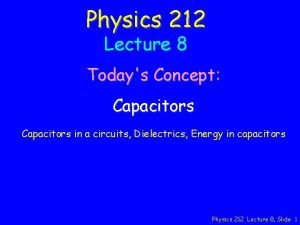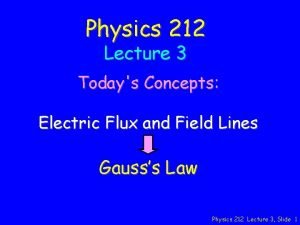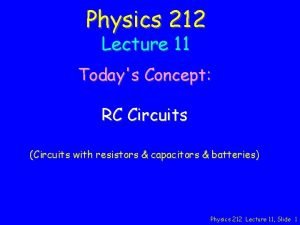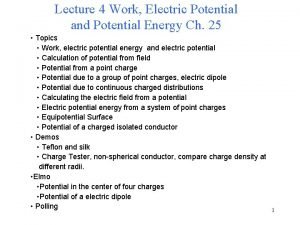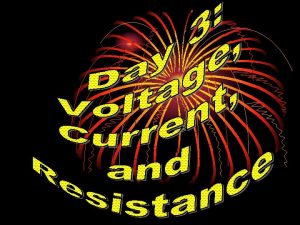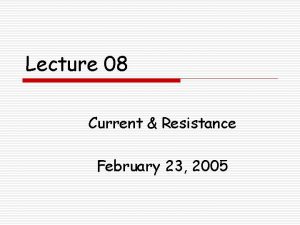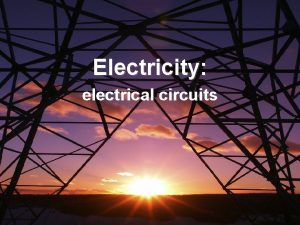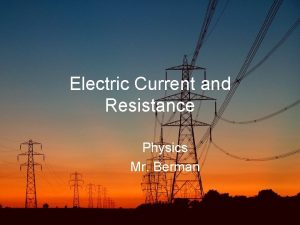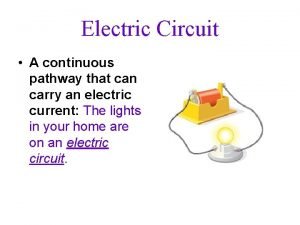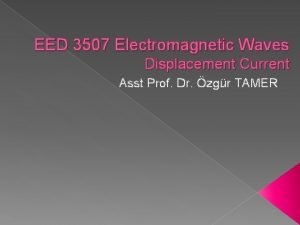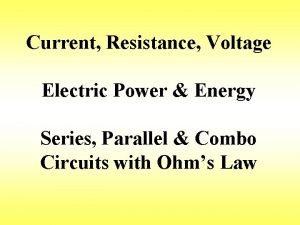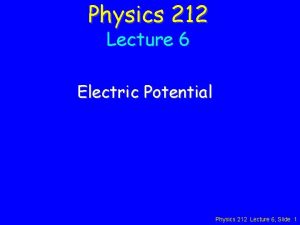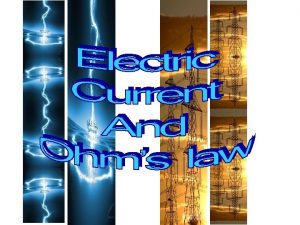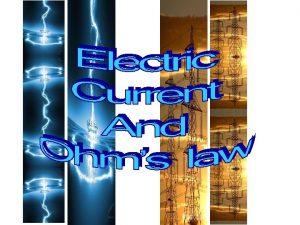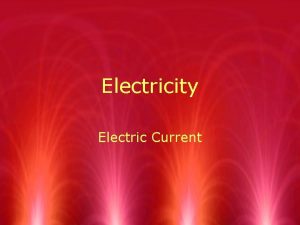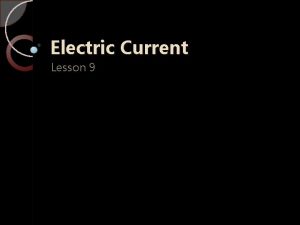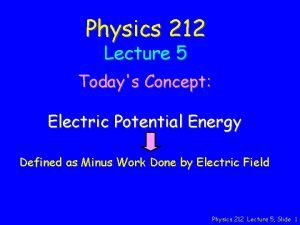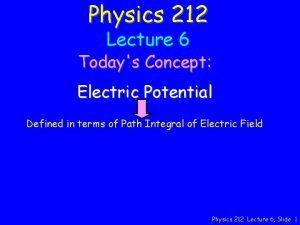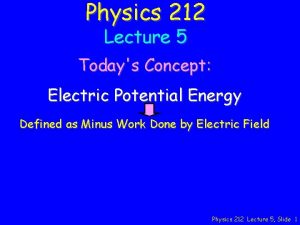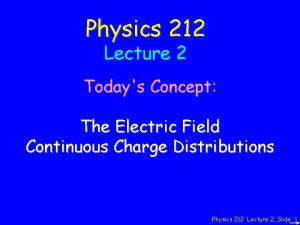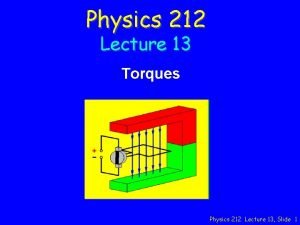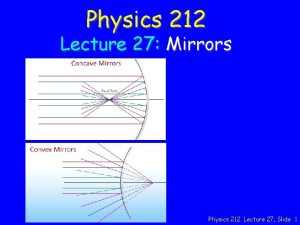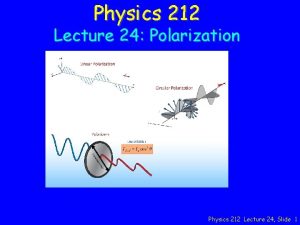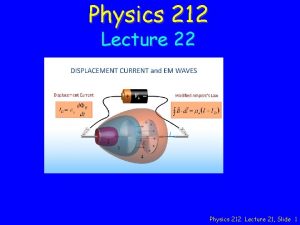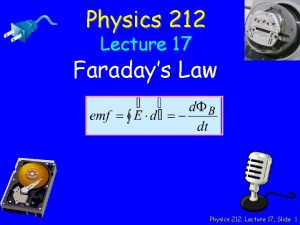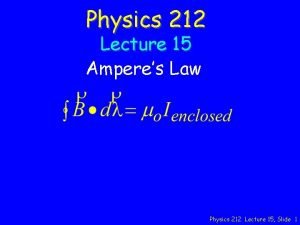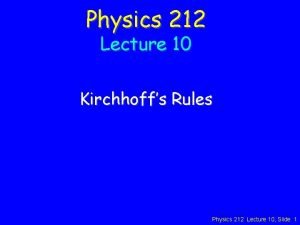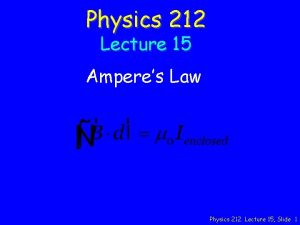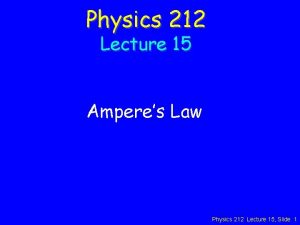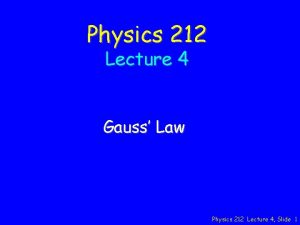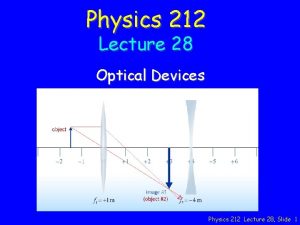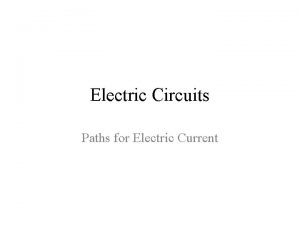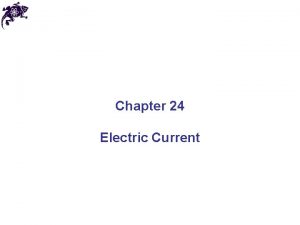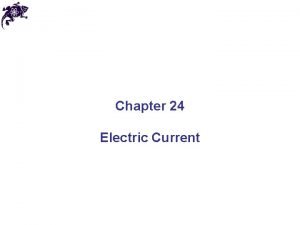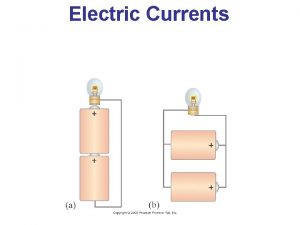Physics 212 Lecture 9 Todays Concept Electric Current






























- Slides: 30

Physics 212 Lecture 9 Today's Concept: Electric Current Ohm’s Law & resistors, Resistors in circuits, Power in circuits Physics 212 Lecture 9, Slide 1

Music Who is the Artist? A) B) C) D) E) Dave Brubeck Thelonius Monk Bill Evans Keith Jarrett Oscar Peterson • Now there’s an example of abstract thinking – composing in real time! • Who will be next!? Physics 212 Lecture 9

Some Exam Stuff • Exam tomorrw (Wed. Feb. 15) at 7: 00 – Covers material through lecture 8 (no resistors) – Bring your ID – Conflict exam at 5: 15 – you will need to stay in the room until exam ends • Where do I go? EXAM ROOMS (by discussion section) • Preparation – Practice exams – Exam Prep Exercises – Worked examples Physics 212 Lecture 8, Slide 3

Your Comments • “This ohmwork wasn't too bad. . . ” • “I hope this exam doesn't fry our circuits. ” • “There was a bug with my prelecture: question number two used the same picture as question one, so i was forced to guess. ” • “The prelecture made sense for the most part, but the checkpoints were pretty tricky. ” • “Not completely sure about the current density, everything else is pretty straight--forward. ” • “a little harder. . let's drill some concepts please!” • “Why does v drift go against the E field. . . ? Why is Ohm's law so different? ” • We’ll do a brief review of the key concepts for the exam • Two atoms were walking down the street one day, when one of them exclaimed, "Oh, no I've lost an electron!" "Are you sure? " the other one asked. "Yes, " replied the first one, "I'm positive. " Physics 212 Lecture 8, Slide 4

A BIG IDEA REVIEW Coulomb’s Law Force law between point charges Electric Field Force per unit charge Gauss’ Law Flux through closed surface is always proportional to charge enclosed Electric Potential energy per unit charge 05 Capacitance Relates charge and potential for two conductor system q 1 q 2 Electric Field Property of Space Created by Charges Superposition Gauss’ Law Can be used to determine E field Spheres Cylinders Infinite Planes Electric Potential Scalar Function that can be used to determine E Physics 212 Lecture 9, Slide 6

APPLICATIONS OF BIG IDEAS Conductors Charges free to move What Determines How They Move? Spheres Cylinders Infinite Planes They move until E = 0 !!! Gauss’ Law E = 0 in conductor determines charge densities on surfaces ls tia en ot uip Eq Fiel d Line s Field Lines & Equipotentials Capacitor Networks Work Done By E Field Change in Potential Energy 05 Series: (1/C 23)=(1/C 2)+(1/C 3) Parallel C 123 = C 1 + C 23 Physics 212 Lecture 9, Slide 7

Key Concepts for Today: 1) How resistance depends on A, L, s, r 2) How to combine resistors in series and parallel 3) Understanding resistors in circuits Today’s Plan: 1) Review of resistance & preflights 2) Work out a circuit problem in detail Physics 212 Lecture 9, Slide 8

I Observables: V = EL I = JA s A o t e t i s o p p o L s i , ” I, w w lo o l f f s t Conductivity – high for good conductors. n n V o e r ctr r u le c l Ohm’s Law: Je = s E a n n o tio i t n rec e v di n o I/A = s. V/L I = V/(L/s. A) C “ : e t No R = resistance r = 1/s = resistivity I = V/R R= L s. A Physics 212 Lecture 9, Slide 9

Checkpoint 3 The SAME amount of current I passes through three different resistors. R 2 has twice the crosssectional area and the same length as R 1, and R 3 is three times as long as R 1 but has the same cross-sectional area as R 1. In which case is the CURRENT DENSITY through the resistor the smallest? A. Case 1 B. Case 2 C. Case 3 “The least electric field is produced from the smallest resistor. Electric field is directly proportional to the current density. ” “same current, more area so less density” “I spreads out along the resistor, which is skinny and long” Physics 212 Lecture 9, Slide 10

Checkpoint 3 The SAME amount of current I passes through three different resistors. R 2 has twice the crosssectional area and the same length as R 1, and R 3 is three times as long as R 1 but has the same cross-sectional area as R 1. In which case is the CURRENT DENSITY through the resistor the smallest? A. Case 1 B. Case 2 C. Case 3 Same Current Physics 212 Lecture 9, Slide 11

This is like plumbing! I is like flow rate of water V is like pressure R is how hard it is for water to flow in a pipe L R= s. A To make R big, make L long or A small To make R small, make L short or A big Physics 212 Lecture 9, Slide 12

Checkpoint 1 a Checkpoint 1 b Same current through both resistors Compare voltages across resistors Physics 212 Lecture 9, Slide 13

Resistor Summary Series Parallel R 1 R 2 Wiring Each resistor on the same wire. Each resistor on a different wire. Voltage Different for each resistor. Vtotal = V 1 + V 2 Same for each resistor. Vtotal = V 1 = V 2 Current Same for each resistor Itotal = I 1 = I 2 Different for each resistor Itotal = I 1 + I 2 Decreases 1/Req = 1/R 1 + 1/R 2 Resistance Increases Req = R 1 + R 2 Physics 212 Lecture 9, Slide 14

Three resistors are connected to a battery with emf V as shown. The resistances of the resistors are all the same, i. e. R 1= R 2 = R 3 = R. Checkpoint 2 a Compare the current through R 2 with the current through R 3: A. I 2 > I 3 B. I 2 = I 3 C. I 2 < I 3 R 2 in series with R 3 Current through R 2 and R 3 is the same Physics 212 Lecture 9, Slide 15

R 1 = R 2 = R 3 = R Checkpoint 2 b Compare the current through R 1 with the current through R 2 I 1 I 2 Checkpoint 2 c Compare the voltage across R 2 with the voltage across R 3 V 2 V 3 Checkpoint 2 d Compare the voltage across R 1 with the voltage across R 2 V 1 V 2 Physics 212 Lecture 9, Slide 16

Checkpoint 2 b R 1 = R 2 = R 3 = R Compare the current through R 1 with the current through R 2 A. I 1/I 2 = 1/2 B. I 1/I 2 = 1/3 C. I 1/I 2 = 1 “current will be the same through 2 and 3, total resistance in r 2 will be double r 1 therefore current will double” “If all of the resistors are the same, then the current through all of them will be the same as well. ” “The resistance in the I 2 path is twice as big” D. I 1/I 2 = 2 E. I 1/I 2 = 3 Physics 212 Lecture 9, Slide 17

Checkpoint 2 b I 1 I 23 R 1 = R 2 = R 3 = R Compare the current through R 1 with the current through R 2 A. I 1/I 2 = 1/2 B. I 1/I 2 = 1/3 We know: Similarly: C. I 1/I 2 = 1 D. I 1/I 2 = 2 E. I 1/I 2 = 3 Physics 212 Lecture 9, Slide 18

Checkpoint 2 c V 23 V 3 R 1 = R 2 = R 3 = R Compare the voltage across R 2 with the voltage across R 3 A V 2 > V 3 B V 2 = V 3 = V C V 2 = V 3 < V D V 2 < V 3 Consider loop Physics 212 Lecture 9, Slide 19

Checkpoint 2 d R 1 = R 2 = R 3 = R Compare the voltage across R 1 with the voltage across R 2 A V 1 = V 2 = V B V 1 = ½ V 2 = V C V 1 = 2 V 2 = V D V 1 = ½ V 2 = 1/5 V E V 1 = ½ V 2 = ½ V “Resistance is the same so voltage is the same. ” “R 2 will draw a greater current, by a factor of 2. Thus v 1 is 1/2 of v 2” “Resistance 1 has voltage V as the battery while resistance 2 and 3 equally share the voltage. ” Physics 212 Lecture 9, Slide 20

Checkpoint 2 d V 1 V 23 R 1 = R 2 = R 3 = R Compare the voltage across R 1 with the voltage across R 2 R 1 in parallel with series combination of R 2 and R 3 A V 1 = V 2 = V B V 1 = ½ V 2 = V C V 1 = 2 V 2 = V D V 1 = ½ V 2 = 1/5 V E V 1 = ½ V 2 = ½ V Physics 212 Lecture 9, Slide 21

R 2 R 1 V R 3 R 4 Calculation In the circuit shown: V = 18 V, R 1 = 1 W, R 2 = 2 W, R 3 = 3 W, and R 4 = 4 W. What is V 2, the voltage across R 2? • Conceptual Analysis: – – Ohm’s Law: when current I flows through resistance R, the potential drop V is given by: V = IR. Resistances are combined in series and parallel combinations • Rseries = Ra + Rb • (1/Rparallel) = (1/Ra) + (1/Rb) • Strategic Analysis – – – Combine resistances to form equivalent resistances: “packing” Evaluate voltages or currents from Ohm’s Law Expand circuit back using knowledge of voltages and currents: “unpacking” Physics 212 Lecture 9, Slide 22

R 2 R 1 V Calculation In the circuit shown: V = 18 V, R 1 = 1 W, R 2 = 2 W, R 3 = 3 W, and R 4 = 4 W. R 3 What is V 2, the voltage across R 2? R 4 • Combine Resistances: R 1 and R 2 are connected: (A) in series (B) in parallel (C) neither in series nor in parallel Parallel Combination Series Combination Parallel: Can make a loop that contains only those two resistors Series : Every loop with resistor 1 also has resistor 2. Physics 212 Lecture 9, Slide 23

R 2 R 1 V R 3 R 4 Calculation In the circuit shown: V = 18 V, R 1 = 1 W, R 2 = 2 W, R 3 = 3 W, and R 4 = 4 W. What is V 2, the voltage across R 2? • We first will combine resistances R 2 + R 3 + R 4: • Which of the following is true? (A) R 2, R 3 and R 4 are connected in series (B) R 2, R 3, and R 4 are connected in parallel (C) R 3 and R 4 are connected in series (R 34) which is connected in parallel with R 2 (D) R 2 and R 4 are connected in series (R 24) which is connected in parallel with R 3 (E) R 2 and R 4 are connected in parallel (R 24) which is connected in parallel with R 3 Physics 212 Lecture 9, Slide 24

R 2 R 1 V Calculation In the circuit shown: V = 18 V, R 1 = 1 W, R 2 = 2 W, R 3 = 3 W, and R 4 = 4 W. R 3 What is V 2, the voltage across R 2? R 4 R 2 and R 4 are connected in series (R 24) which is connected in parallel with R 3 Redraw the circuit using the equivalent resistor R 24 = series combination of R 2 and R 4. (A) (B) (C) Physics 212 Lecture 9, Slide 25

Calculation R 1 V R 3 In the circuit shown: V = 18 V, R 1 = 1 W, R 2 = 2 W, R 3 = 3 W, and R 4 = 4 W. R 24 • Combine Resistances: What is V 2, the voltage across R 2? R 2 and R 4 are connected in series = R 24 R 3 and R 24 are connected in parallel = R 234 What is the value of R 234? (A) R 234 = 1 W (B) R 234 = 2 W R 2 and R 4 in series (1/Rparallel) = (1/Ra) + (1/Rb) (C) R 234 = 4 W (D) R 234 = 6 W R 24 = R 2 + R 4 = 2 W + 4 W = 6 W 1/R 234 = (1/3) + (1/6) = (3/6) W-1 R 234 = 2 W Physics 212 Lecture 9, Slide 26

R 1 V I 1 = I 234 Calculation In the circuit shown: V = 18 V, R 1 = 1 W, R 2 = 2 W, R 3 = 3 W, and R 4 = 4 W. R 234 R 24 = 6 W R 234 = 2 W What is V 2, the voltage across R 2? R 1 and R 234 are in series. R 1234 = 1 + 2 = 3 W Our next task is to calculate the total current in the circuit V Ohm’s Law tells us = I 1234 R 1234 I 1234 = V/R 1234 = 18 / 3 = 6 Amps Physics 212 Lecture 9, Slide 27

Calculation: begin unpacking V I 1234 R 1 a V R 234 = I 1 = I 234 In the circuit shown: V = 18 V, R 1 = 1 W, R 2 = 2 W, R 3 = 3 W, and R 4 = 4 W. R 24 = 6 W R 234 = 2 W I 1234 = 6 A What is V 2, the voltage across R 2? I 234 = I 1234 Since R 1 in series w/ R 234 V 234 = I 234 R 234 =6 x 2 b = 12 Volts • What is Vab, the voltage across R 234 ? (A) Vab = 1 V (B) Vab = 2 V (C) Vab = 9 V (D) Vab = 12 V (E) Vab = 16 V Physics 212 Lecture 9, Slide 28

Calculation R 1 V V R 234 R 3 R 24 V = 18 V R 1 = 1 W R 2 = 2 W R 3 = 3 W R 4 = 4 W. R 24 = 6 W R 234 = 2 W I 1234 = 6 Amps I 234 = 6 Amps V 234 = 12 V What is V 2? Which of the following are true? A) V 234 = V 24 B) I 234 = I 24 C) Both A+B R 3 and R 24 were combined in parallel to get R 234 D) None Voltages are same! Ohm’s Law I 24 = V 24 / R 24 = 12 / 6 = 2 Amps Physics 212 Lecture 9, Slide 29

Calculation R 1 V I 1234 R 3 R 1 V R 24 I 24 R 2 R 3 R 4 Which of the following are true? A) V 24 = V 2 B) I 24 = I 2 C) Both A+B R 2 and R 4 where combined in series to get R 24 D) None V = 18 V R 1 = 1 W R 2 = 2 W R 3 = 3 W R 4 = 4 W. R 24 = 6 W R 234 = 2 W I 1234 = 6 Amps I 234 = 6 Amps V 234 = 12 V V 24 = 12 V I 24 = 2 Amps What is V 2? Currents are same! Ohm’s Law The Problem Can Now Be Solved! V 2 = I 2 R 2 = 2 x 2 = 4 Volts! Physics 212 Lecture 9, Slide 30

I 1 V R 1 Quick Follow-Ups R 2 I 2 R 1 I 3 = R 3 V R 4 (B) I 3 = 3 A V 3 = V 234 = 12 V R 234 b • What is I 3 ? (A) I 3 = 2 A a (C) I 3 = 4 A I 3 = V 3/R 3 = 12 V/3 W = 4 A V = 18 V R 1 = 1 W R 2 = 2 W R 3 = 3 W R 4 = 4 W. R 24 = 6 W R 234 = 2 W V 234= 12 V V 2 = 4 V I 24 = 2 Amps I 1234 = 6 Amps • What is I 1 ? We know I 1 = I 1234 = 6 A NOTE: I 2 = V 2/R 2 = 4/2 = 2 A I 1 = I 2 + I 3 Make Sense? ? ? Physics 212 Lecture 9, Slide 31
 Conceptual physics chapter 23 electric current
Conceptual physics chapter 23 electric current Q=vc physics
Q=vc physics Physics 212 gradebook
Physics 212 gradebook Todays concept
Todays concept 01:640:244 lecture notes - lecture 15: plat, idah, farad
01:640:244 lecture notes - lecture 15: plat, idah, farad Electric potential lecture
Electric potential lecture Electric potential lecture
Electric potential lecture A balanced delta connected load having an impedance 20-j15
A balanced delta connected load having an impedance 20-j15 Difference between phase voltage and line voltage
Difference between phase voltage and line voltage Energy band diagram of pn junction diode
Energy band diagram of pn junction diode Ac systems lesson 4
Ac systems lesson 4 Drift current and diffusion current in semiconductor
Drift current and diffusion current in semiconductor Ceramic composition resistors
Ceramic composition resistors The value of vgs that makes id approximately zero is the
The value of vgs that makes id approximately zero is the Wye and delta connections
Wye and delta connections Slideplayer
Slideplayer Drift current and diffusion current in semiconductor
Drift current and diffusion current in semiconductor Dcep welding
Dcep welding Touch current vs leakage current
Touch current vs leakage current Kcl mesh analysis
Kcl mesh analysis Def voltage
Def voltage Resistance is the opposition to
Resistance is the opposition to What
What Chapter 23 electric current circuit happenings
Chapter 23 electric current circuit happenings Stokes's theorem
Stokes's theorem Rope loop model electricity
Rope loop model electricity Units of electric current
Units of electric current Pathway for carrying an electric current
Pathway for carrying an electric current Maximum displacement current
Maximum displacement current How to find i total in a parallel circuit
How to find i total in a parallel circuit Water
Water
